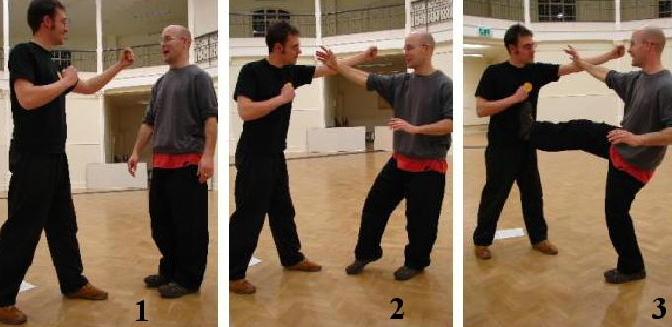COUNTERS AGAINST BOXERS' FAST JABS
The following discussion is reproduced from the thread A Discussion on Yielding started in the Shaolin Wahnam Discussion Forum on 14th February 2006. The name of a main contributor to this thread is removed as requested by him, and is replaced by “Challenger” or any term appropriate to the occasion. As the discussion is long, it is presented here in parts.
 Simon uses "Cross Hands Thrust Kick" to counter Sifu Marcus' jab
Simon uses "Cross Hands Thrust Kick" to counter Sifu Marcus' jab
 Sifu Marcus Santer
Sifu Marcus Santer
Instructor, Shaolin Wahnam England
23rd March 2006
Dear all,
Thank you for your patience. Before I post the remaining picture sequences and video footage to highlight some of what has gone before I'd like to make the following notice.
Simon and I were having far too much fun whilst the pictures were being taken, hence some of them are not carbon copies of the text they relate to, but they are close enough for you to get the picture (pardon the pun ). They were also taken in too much of a hurry as I had a class to start and on some of them the camera person forgot to include our feet, I assure you this was not intentional as I know some of you like to look at the feet first Unfortunately on the night Simon and I were both wearing black trousers, which I hope won't make it too difficult to work out whose leg is whose (I would have worn my bright red trousers, but I've lent them to Hubert).
Just thought I'd mention it.
So ladies and gentlemen let us proceed.
In post 30 I wrote:
Quote:
“There are many effective techniques in Tai Chi Chuan against the fast jab. For example, the Tai Chi Chuan practitioner may use 'Cross Hand Thrust Kick'. He moves diagonally aside, spreads his hands above to distract the opponent, and simultaneously kicks him below (using the strategy "Signal high, strike low"). Here he uses spacing to overcome the opponent's timing. No matter how fast the opponent's jabs are, the Tai Chi Chuan practitioner spaces himself in such manner that they cannot reach him despite their speed.”
Picture 1: I move in to jab at Simon
Picture 2: Simon and I forget that he is supposed to move diagonally aside (moving out of range of my jab) and distract my attention by signalling high with his arms
Picture 3: Simon completes by kicking me below.
I will post the picture sequence for another Jab tomorrow.
Kind regards
Marcus
Joko
Shaolin Wahnam Indonesia
23rd March 2006
Dear Marcus Sihing,
Thanks for providing the sequence.
To which side can Simon move diagonally? Can he do it either to the left or right?' As you are punching with a left jab, is it also possible for Simon to move diagonally to the right, and then kick with his left leg? (and left side kick perhaps, instead of thrust kick). Or if he moves to the left, he kicks with his right leg. Which one is better?
And also can this be categorized as yielding or “no defence direct counter”?
Thanks,
Joko
__________________
kai xin... hao yunqi...
Be happy n joyful... and share the joy with others

Sifu Wong leading a Taijiquan class in performing “Cross Hands Thrust Kick” during an Intensive Taijiquan Course
Barry
Shaolin Wahnam England
23rd March 2006
As I have little combat experience I can really only talk about yielding in other than combat situations. I think Piers comments raise some interesting points:
Quote:
“So my understanding of yielding is that, broadly speaking, it's giving way to an attack so as ultimately to gain an advantage.”
For me this raises the idea of gaining an advantage, which in turn raises the idea of the intention behind gaining an advantage.
One possible intention is:
Quote
“a soft answer turneth away wrath”
One interpretation of the intention being to turn away wrath
Another might be:
Quote
“Or, sidestepping someone who's charging at you so they hurt themselves with their own force.”
One interpretation of the intention being that the other hurts himself.
Other intentions might be to avoid harm to oneself, to allow someone space to express their aggression without anyone getting hurt, to give the other person space to learn a lesson (that "lesson" might be one you want to teach them or one they discover unexpectedly i.e. without you or them having any prior understanding of what it might be).
I am looking at yielding from the perspective of the way I run groups, which includes some profoundly disturbed people. This thread has helped me to look at the way I "yield" in these groups and the various intentions there might be behind it.
My intentions, which I notice before, and then try to let go are "to do no harm" and "to do good". So, when someone begins to self-harm in the group, which is often a despairing way of trying to express some aspect of themselves they can't cope with, how should I yield - neutralize the possible harmful impact on them, others or myself and help the energy contained in that act to be useful. When someone fears that another dislikes them, in a way that leads to panic and a desire to flee from the room how do I yield to achieve the same end. For me it is useful to know what my intention is. I practice various ways of being and see what moves towards the aim and what moves away from the aim.
However, I also realize that there is a potential danger in me having any intention of doing good. It possibly introduces my notion of what is good and bad into the group. As time goes on I realize more and more that if I spend my time only directing people towards behaviour, attitudes, beliefs and interpersonal interactions that I deem "good" I take away their possibility to express themselves and learn. So, I also need to yield to a process I don't understand. I know that when I go in with the intention of manifesting compassion and wisdom in the group, and then let it go, people seem to get things out of them. It then just becomes intention and letting go, which I seem as a form of yielding. Intention then becomes the key thing.
Piers, I have been really enjoying your posts lately.
Barry
 Sifu Marcus Santer
Sifu Marcus Santer
Instructor, Shaolin Wahnam England
Hello Joko,
In picture 1 as Simon has his weight (apparently) distributed evenly on both feet then he can move diagonally to the left or to the right. Because the technique emphasizes spacing then in this specific situation it doesn't really matter whether Simon moves to the left, to the right, kicks with the left leg or the right leg.
The second technique used in the description is “Signal High, Strike Low” (not adequately demonstrated in this picture sequence). Personally I'd use an organ seeking kick like Yellow Bird.
The key strategies in this sequence are spacing and Signal High Strike Low.
I will post the sequence for "warding off" a fast jab later this evening after my practice.
Kind regards
Marcus
LINKS
